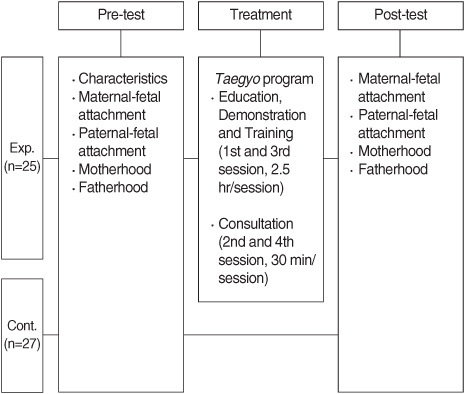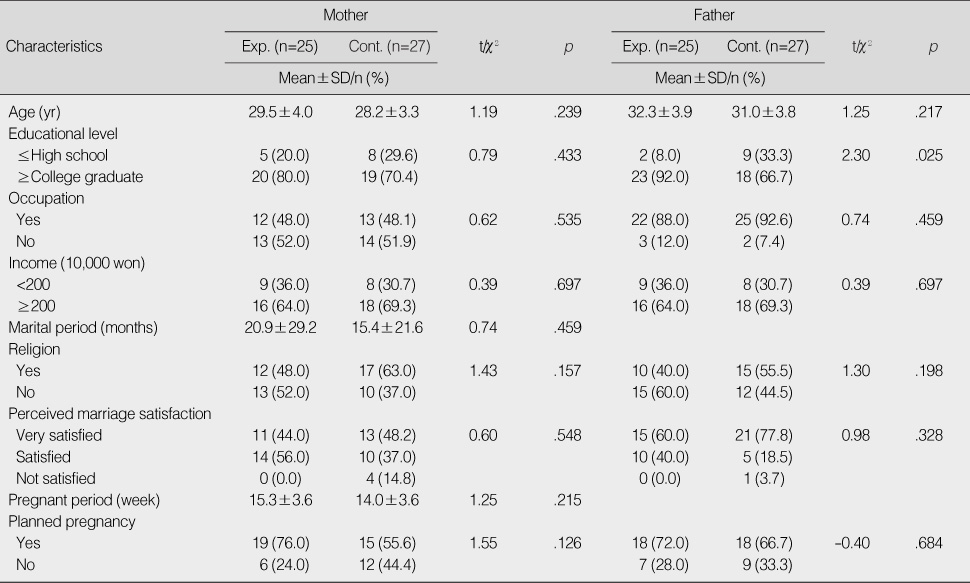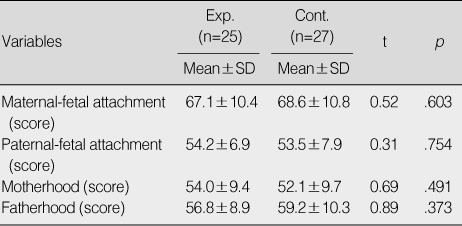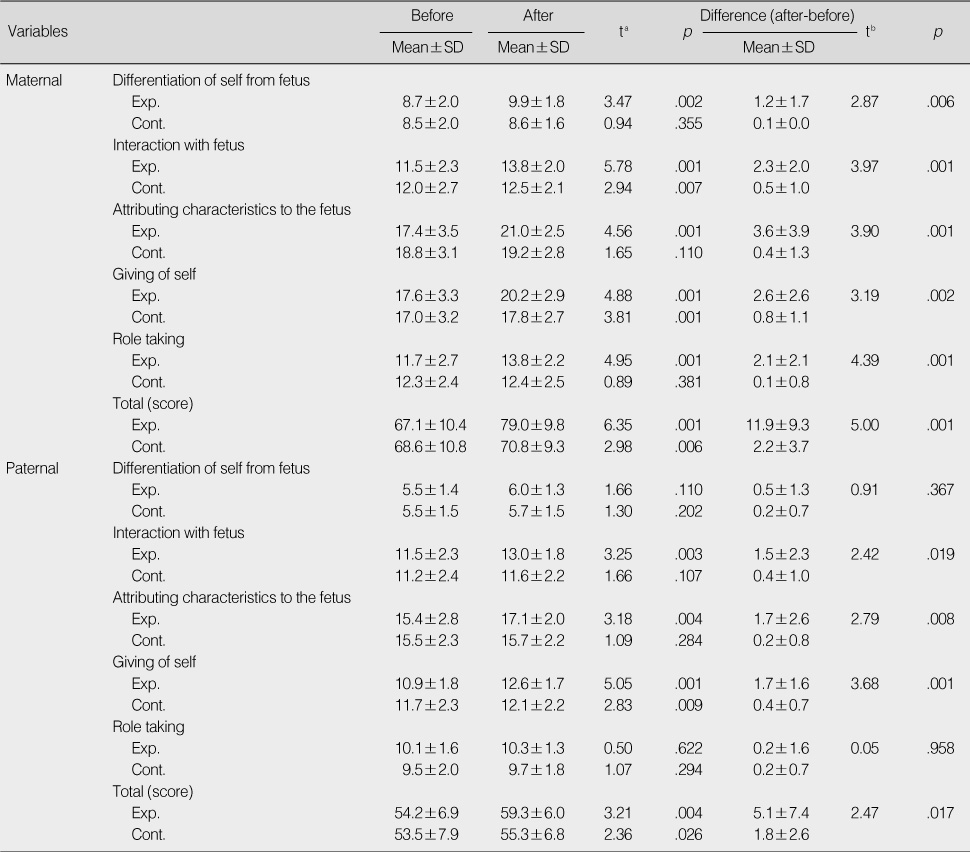Articles
- Page Path
- HOME > J Korean Acad Nurs > Volume 40(4); 2010 > Article
-
Original Article
-
Effects of a
Taegyo Program on Parent-Fetal Attachment and Parenthood in First Pregnancy Couples - Kyung Mi Yang, Soon-Lae Kim
-
Journal of Korean Academy of Nursing 2010;40(4):571-579.
DOI: https://doi.org/10.4040/jkan.2010.40.4.571
Published online: August 31, 2010
1Full-time Lecturer, Department of Nursing, Chunnam Techno College, Gokseong, Korea.
2Professor, College of Nursing, The Catholic University of Korea, Seoul, Korea.
- Address reprint requests to: Kim, Soon-Lae. College of Nursing, The Catholic University of Korea, 505 Banpo-dong, Seocho-gu, Seoul 137-701, Korea. Tel: 82-2-2258-7404, Fax: 82-2-2258-7772, slkim@catholic.ac.kr
Copyright © 2010 Korean Society of Nursing Science
Abstract
-
Purpose
- The purpose of this study was to explore the effects of a Taegyo program on parents-fetal attachment and parenthood in first pregnancy couples (mothers and spouses).
-
Methods
- The research design was a nonequivalent control group pretest-posttest experiment. Study participants were 52 first pregnancy couples visiting two medium-scale obstetrics and gynecology clinics located in Gwangju. A total of 52 couples were assigned to the experimental group (25 couples) and the control group (27 couples). The experimental couples were provided with a Taegyo program for 4 weeks. Data were analyzed by chi square test, t-test, and ANCOVA using the SPSS program.
-
Results
- Post-treatment maternal-fetal attachment, paternal-fetal attachment and motherhood significantly increased in the experimental group as compared to the control group, but post-treatment fatherhood, anxiety, blood pressure and pulse of participants in the experimental group showed no significant difference from those in the control group.
-
Conclusion
- From these results, it is suggested that the Taegyo program has beneficial effects in enhancing parent-fetal attachment and motherhood in first pregnancy couples. Therefore, a Taegyo program can be recommended as a nursing intervention program for first pregnancy couples.
This article is based on a part of the first author's doctoral thesis from the Catholic University of Korea.
- 1. Buki's donghwanara. 2010;Retrieved August 10, 2010. Donghwanara. from http://www.buki.co.kr/main.php.
- 2. Cha EJ. A study on the effects of presence at delivery on the paternal attachment behavior. 1985;Seoul, Ewha Womans University. Unpublished master's thesis.
- 3. Choi SS. Taegyosingi. 2002;Seoul, Seongbosa.
- 4. Choi YS, Kim HO. A survey on the practice of taekyo among childbearing couples. Korean Journal of Women Health Nursing. 1995;1:153–173.ArticlePDF
- 5. Cranley MS. Development of a tool for the measurement of maternal attachment during pregnancy. Nursing Research. 1981;30:281–284.PubMed
- 6. Donovan J. The process of analysis during a grounded theory study of men during their partners' pregnancies. Journal of Advanced Nursing. 1995;21:708–715.ArticlePubMed
- 7. Hong EJ, Lee JY. The effects of the 'taegyo' program using art therapy techniques on the anxiety, postpartum depression and maternal identity of pregnant women. The Korean Journal of human development. 2006;13:97–115.
- 8. Jessop LC. Promoting maternal attachment through prenatal intervention. Maternal-Child Nursing Journal. 1981;6:107–112.Article
- 9. Kim HO. An ethnographic study about taegyo practice in korea. 1997;Seoul, Yonsei University. Unpublished doctoral dissertation.
- 10. Kim HS. Patterning of parent-fetal attachment during the experience of guided imagery. Korean Journal of Nursing Query. 1992;1:118–144.
- 11. Kim JS, Cho KJ. The effect of mother-fetus interaction promotion program of talking and tactile stimulation on maternal-fetal attachment. Journal of Korean Academy of Child Health Nursing. 2004;10:153–164.
- 12. Kim SY. Thomas Verny. In: The secret life of the unborn child. 2005;Seoul, Samtoh Publishing. Original work published 1981.
- 13. Kim YJ. The effect of a maternal fetal relationship enhancement program on mother's fetal attachment. 2005;Seoul, Yonsei University. Unpublished master's thesis.
- 14. Kim YK. Gisco Ssedik. In: Fetus is genius. 2006;Seoul, Samtoh Publishing. Original work published 1986.
- 15. Koh HJ. The relationship between role strain and identity in first-time mothers with regard to employment status. 1996;Seoul, Ewha Womans University. Unpublished doctoral dissertation.
- 16. Koniak-Griffin D, Verzemnieks I. Effects of nursing intervention on adolescents' maternal role attainment. Issues in Comprehensive Pediatric Nursing. 1991;14:121–138.ArticlePubMed
- 17. Mun HS, Choi ES. A study on the cognition and practice of the delivered woman and her husband for the fetal education. Korean Journal of Women Health Nursing. 2002;8:583–594.ArticlePDF
- 18. Park JH. The effect of visual and verbal information by antenatal ultrasound on maternal-fetal attachment and self-care. 2001;Seoul, Yonsei University. Unpublished master's thesis.
- 19. Park MI. Taegyo is science. 2001;Seoul, Hanyang University Publishing.
- 20. Shin MH. Lovevoice taegyolyagi. 2003;Seoul, Hanyang University Publishing.
- 21. Seongpoomtaekyo. Shinmaehee's beautiful seongpoomtaekyo. 2010;Retrieved August 10, 2010. from http://www.lovevoice.org/sub_01/01_04.html.
- 22. eaver RH, Cranley MS. An exploration of paternal-fetal attachment behavior. Nursing Research. 1983;32:68–72.PubMed
- 23. Yoo HJ, Kim S.H. The effects of the prenatal program using meditation and art activities on the emotional rest of pregnant women. The Korean Journal of Meditationtherapy. 2008;2:249–284.
REFERENCES
Figure & Data
REFERENCES
Citations

- First-time fathers' experiences during their transition to parenthood: A study of Korean fathers
Nan Iee Noh
Child Health Nursing Research.2021; 27(3): 286. CrossRef - Correlations among Perceptions and Practice of Taegyo and Maternal-Fetal Attachment in Pregnant Women
Sang-Youn Jang, Kyung-Sook Bang
Child Health Nursing Research.2019; 25(4): 398. CrossRef - Factors Influencing Happiness among Pregnant Women in the Ecological Systems Theory
Gyuree Lee, Hyunkyung Choi
Journal of Korean Academy of Community Health Nursing.2019; 30(1): 11. CrossRef - Concept Analysis of Forest Taegyo
Insook Lee, 이윤정, Sungjae Kim, Jang Sang Youn, 문민지, Kyungsook Bang, 김다솜
The Journal of Korean institute of Forest Recreation.2018; 22(3): 31. CrossRef - Relationship among Emotional Clarity, Maternal Identity, and Fetal Attachment in Pregnant Women with Gestational Diabetes Mellitus
Su Min Lee, Hye-Ja Park
Korean Journal of Women Health Nursing.2017; 23(2): 99. CrossRef - The effects of personal characteristics, marital intimacy and family support of pregnant couples on parent-fetal attachment
강수경, Mira Chung, 최지현
EARLY CHILDHOOD EDUCATION & CARE.2017; 12(2): 223. CrossRef - TÜRK MÜZİĞİNİN GEBELİK VE YENİDOĞAN ÜZERİNDEKİ ETKİLERİ
Fatma ÇOŞAR ÇETİN, Ali TAN, Yeliz DOĞAN MERİH
Zeynep Kamil Tıp Bülteni.2017;[Epub] CrossRef - Development of the Korean Paternal-Fetal Attachment Scale (K-PAFAS)
Nan Iee Noh, Hye-Ah Yeom
Asian Nursing Research.2017; 11(2): 98. CrossRef - Factors associated with Maternal-fetal Attachment of Expectant Mothers Whose Fetus Has a Prenatal Diagnosis of Congenital Heart Disease
Yu-Mi Im, Eun-Sook Kim, Il-Young Yoo
Journal of Korean Academy of Child Health Nursing.2012; 18(3): 150. CrossRef - Music Therapy on Anxiety, Stress and Maternal-fetal Attachment in Pregnant Women During Transvaginal Ultrasound
Hye Sook Shin, Ju Hee Kim
Asian Nursing Research.2011; 5(1): 19. CrossRef

Figure 1
Homogeneity Test for General Characteristics
Exp.=Experimental group; Cont.=Control group.
Homogeneity Test for Research Variables
Exp.=Experimental group; Cont.=Control group.
Effects of Taegyo Program on Maternal-Fetal and Paternal-Fetal Attachment
ta=paired t-test; tb=unpaired t-test; Exp.=Experimental group (n=25); Cont.=Control group (n=27).
Effects of Taegyo Program on Motherhood and Fatherhood
ta=paired t-test; tb=unpaired t-test; Exp.=Experimental group (n=25); Cont.=Control group (n=27).
Exp.=Experimental group; Cont.=Control group.
Exp.=Experimental group; Cont.=Control group.
ta=paired t-test; tb=unpaired t-test; Exp.=Experimental group (n=25); Cont.=Control group (n=27).
ta=paired t-test; tb=unpaired t-test; Exp.=Experimental group (n=25); Cont.=Control group (n=27).
 KSNS
KSNS
 E-SUBMISSION
E-SUBMISSION





 Cite
Cite

